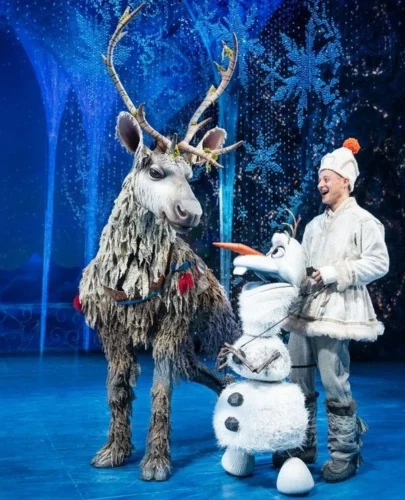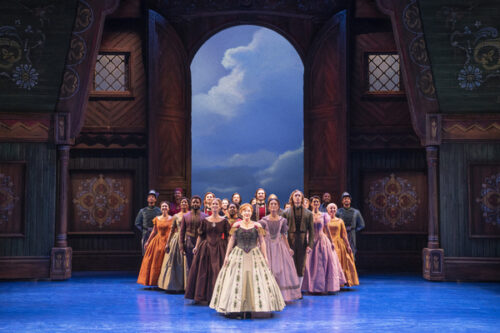Frozen: Perfectly Fine
The film this musical is based on was such a hit in 2013 that anyone alive then or since then is at least aware of it, its characters, and can hum “Let it Go.” I’ve seen near infinite Frozen merchandise over the years, ranging all the way from boxed Mac & Cheese to men’s sweaters. I was a teenager when it came out and saw it in theaters with friends, enjoyed it and even bought the album off iTunes (possibly the last digital album I ever bought). In this review I’m going to assume that you’re seen it, because if you maintained the effort to avoid seeing it for the past eleven years you’ll have no interest in this review anyways.

Disney took its time making the adaptation, which made its Broadway debut in 2018, continuing until the COVID lockdown. The North American Tour began in 2019 and continued after the COVID interruption, playing its 1,000 performance earlier this year. Jennifer Lee, who wrote the film, did the book, and the original song-writers for the film, husband-wife duo Robert Lopez (co-creator of The Book of Mormon) and Kristen Anderson-Lopez wrote the new music for the Broadway adaptation, promising at least the potential of equally good songs.
Before going in to see it, my greatest hope for the Broadway adaptation was that the notable lopsidedness of its music would get balanced: the first half of the movie has seven fabulous songs, some almost back-to-back, yet the second half has only two, one of which is a reprise. Perhaps the plot would get fleshed out a little too: they’re orphaned as children and Elsa isn’t crowned until she comes of age, but there’s no a regent, or even anyone in an authority position. There’s nobody to take the command of the land when the princesses disappear except for some random foreign prince who is unofficially engaged to the younger princess. I also hoped Kristoff would be likable, his personality expanded beyond being a crude masculine stereotype.
The adaptation doesn’t give new depth, but parts are changed: Elsa is shown to have a little more compassion and care for others. Kristoff is indeed improved, now a somewhat brusque but kind and independent man who is an outsider rather than a loser. Hans is also better, maybe because they didn’t give him those creepy sideburns. The scheming ambassador from Weselton still basically does nothing, but is funnier. Sadly, though, Anna (my favorite character in the film) is now slightly annoying. Most notably, there are no rock trolls, but “Hidden Folk,” rustic people half-dressed in wild nordic furs. It’s an understandable choice, but it would have been delightful to watch a lavish puppet show for the trolls (the animated trolls do have a rather Muppety look). Instead, the Hidden Folk deliver the same lines while doing a squatting-swaying movement in an attempt to convey wildness.
The adaptation tries to add a few jokes for the parents by adding clumsy innuendos. Anna’s song “For the First Time in Forever,” has its tone shifted by these jokes, from being joyful and hopeful to a little, well, horny: Anna strokes a bust of a man’s muscular torso, and then later, when singing with Hans, puts her flat hand on his chest and slides it a few inches lower towards his crotch. It is unexpectedly awkward. This isn’t helped by the fact that the woman playing teenage Anna is clearly an adult. Usually innuendos make me chuckle, but these annoyed me, probably because they change the tone of the innocent Disney brand fairy tale.
Obviously, the music is a big part of the musical, particularly the new songs created specially for it. It was an impossible task. To begin with, most viewers are lovingly familiar with all the songs from the movie. So how can you insert new songs in the same story and not have them feel like interlopers? The new music is fine, but not particularly memorable, and at times feels a little retro-80’s pop unlike the film’s music. One musical choice I actively disliked was the replacement of the “For the First Time in Forever (Reprise)” when Anna finally confronts Elsa in her ice castle. It’s such a thrilling musical moment with an expert blending of their two contrasting melodies, and it was replaced with an unfamiliar song communicating mostly the same thing, except now without Anna. At least now the number of songs in the second act make it feel more balanced, as I had hoped.
The musical’s special effects have been talked up, and they aren’t bad. Most of the effects are flashes of light, sprinklings of snow, and well-designed projections casting a limn of frost over the stage. A few moments are surprising, ice-like confetti appearing from unexpected places, or when young Elsa and Anna build a moving Olaf from toys in their bedroom. My favorite effect is at the end, when Anna is frozen. The ensemble has been dancing around in all-white attire, personifying the blizzard, and suddenly they join her, draping a massive cloth over her and themselves. At that moment they become motionless and the projectors blast a perfectly designed image of frost over them. They truly look frozen. The moment that got the biggest gasp from the crowd is during Elsa’s “Let it Go.” In the film there’s a moment when she magically transforms her dress. Here they have her on a high portion of the stage and she dramatically throws her arms down to have the dress suddenly ripped off to reveal a sparkling dress underneath.

The special effects and costuming meet to create Olaf and Sven. Olaf, the dismemberable snowman, is a large chest-high puppet, attached to the actor playing the role. He moves the mouth and hands of the puppet, and the Olaf’s feet are attached to his own. The actor wears an all-white Scandinavian outfit with a funny hat. The puppet is fun to watch, and you can see the actor’s face for more detailed expressions. Sven, whom I found boring in the film, is the coolest thing on stage. The detailed design is cool, with an animatronic look and movement to its features, but containing a person who nimbly walks around on all fours. I found myself staring at Sven every moment he was on stage. To see a quick montage of the costume, piece by piece, see The Secret Life of Sven – The New York Times.
The costumes are lovely and lavish. Even the common people’s attire have many layers of cloth, which they use as they dance to create added movement. The ensemble’s choreography is fun, especially at the ball, but the main characters generally just stand and sing. The new song to start off the second act, “Hygge,” involves a goofy “nude” chorus line of sauna-goers who always manage to cover themselves up with tree branches, and it got a lot of laughs.

The set pieces are great, massive and with layers giving added depth to the stage. The backdrop is a large screen, and it’s used exactly as it should be: as a backdrop. It works well with the set pieces and deftly joins in with the special effects of frost and snow. My favorite set is the castle, with its attractive wood walls and designs.
I saw the show Wednesday, May 8, so the audience was smaller than it would have been had there not been tornadoes. A large swathe of the crowd was families with children, boys and girls. Most of the girls were in some degree of Elsa attire. I discovered that TPAC has booster seats for Jackson Hall. The kids behaved well, although at one point, when Olaf sings his song “In Summer,” there’s a classic joke, “Winter’s a good time to stay in and cuddle, but put me in summer and I’ll be a [comical pause] happy snowman!” Some little boy towards the front yelled out “Puddle” with uncontrollable enthusiasm in that moment of quiet and got everyone to laugh, including Olaf. During intermission kids were hyper and happy: the show kept them engaged and they seemed to enjoy it a lot. The musical is barely longer than the movie, and that is counting the one twenty minute intermission.
Caroline Bowman does a fantastic job as Elsa (a must when we’re all familiar with Idena Menzel’s version). Lauren Nicole Chapman has a strong, capable voice. Nicholas Edwards makes the best version of Kristoff, a marvelous singer and a winning actor. Preston Perez makes Hans actually charming and I wish we could see more of his villainous side. Jeremy Davis is eminently likable and has perfect comic timing as Olaf, puppeteering smoothly. Weselton is played by Evan Duff, who makes the character’s bad dancing hilarious. Dan Plehal played Sven the night I attended with impressive agility.
I took a lot of space here to say something simple: the musical is a solid adaptation of an excellent children’s film, and it faces all the usual limitations of adapting from animation to live action. Too big to fail, Frozen: The Broadway Musical would be a hit even if everyone involved completely dropped the ball. Luckily, they didn’t. Adults will find it good enough, superfans will automatically love it, and the kids will really enjoy it. For children new to Broadway Frozen could be a good way to start their experience.
Frozen will continue at TPAC’s Jackson Hall through May 18. For tickets and more information, see Disney’s Frozen | Broadway Shows in Nashville at TPAC or Disney FROZEN | The Broadway Musical.



